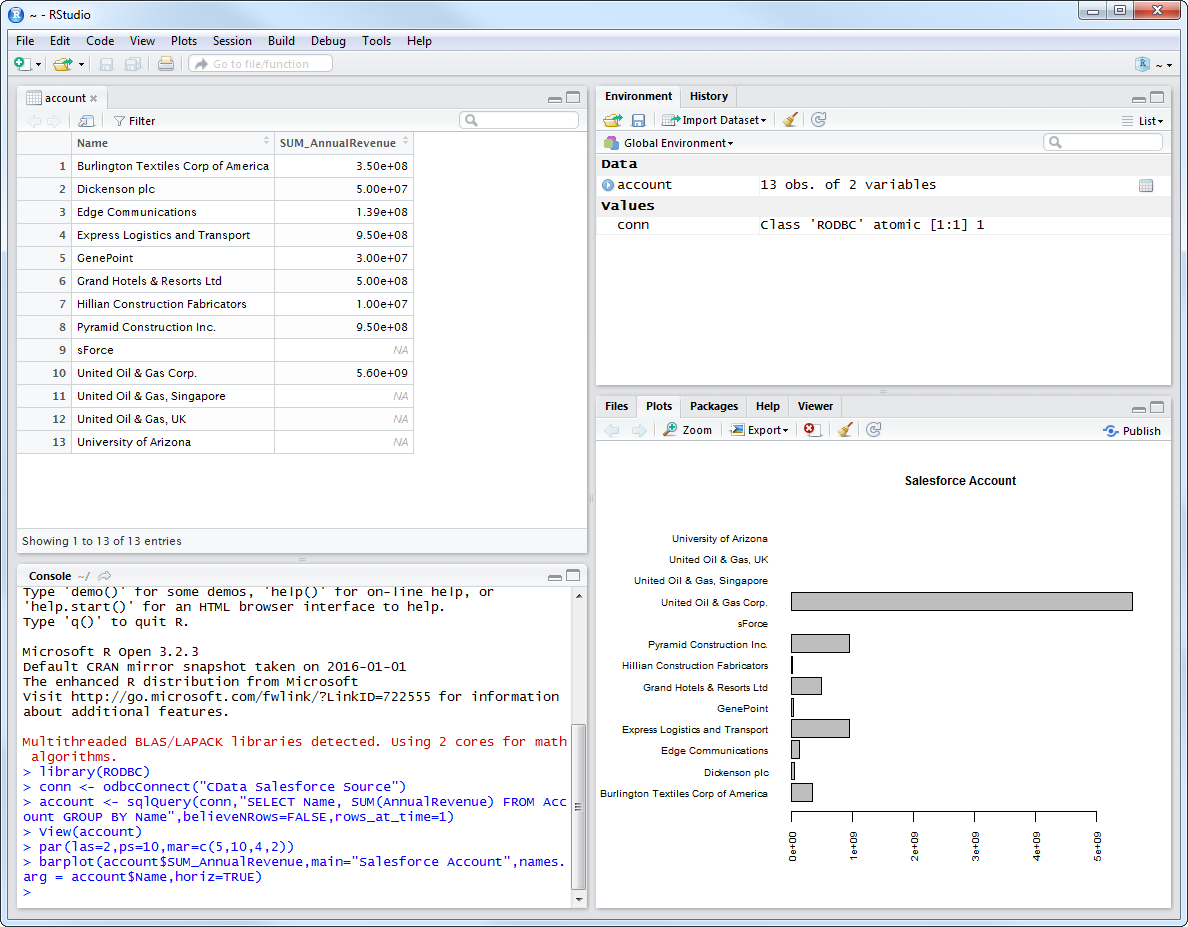Discover how a bimodal integration strategy can address the major data management challenges facing your organization today.
Get the Report →Analyze SAP Ariba Procurement Data in R
Create data visualizations and use high-performance statistical functions to analyze SAP Ariba Procurement data in Microsoft R Open.
Access SAP Ariba Procurement data with pure R script and standard SQL. You can use the CData ODBC Driver for SAP Ariba Procurement and the RODBC package to work with remote SAP Ariba Procurement data in R. By using the CData Driver, you are leveraging a driver written for industry-proven standards to access your data in the popular, open-source R language. This article shows how to use the driver to execute SQL queries to SAP Ariba Procurement data and visualize SAP Ariba Procurement data in R.
Install R
You can complement the driver's performance gains from multi-threading and managed code by running the multithreaded Microsoft R Open or by running R linked with the BLAS/LAPACK libraries. This article uses Microsoft R Open (MRO).
Connect to SAP Ariba Procurement as an ODBC Data Source
Information for connecting to SAP Ariba Procurement follows, along with different instructions for configuring a DSN in Windows and Linux environments.
In order to connect with SAP Ariba Procurement, set the following:
- ANID: Your Ariba Network ID.
- ANID: Specify which API you would like the provider to retrieve SAP Ariba data from. Select the Buyer or Supplier API based on your business role (possible values are PurchaseOrdersBuyerAPIV1 or PurchaseOrdersSupplierAPIV1).
- Environment: Indicate whether you are connecting to a test or production environment (possible values are TEST or PRODUCTION).
Authenticating with OAuth
After setting connection properties, you need to configure OAuth connectivity to authenticate.
- Set AuthScheme to OAuthClient.
- Register an application with the service to obtain the APIKey, OAuthClientId and OAuthClientSecret.
For more information on creating an OAuth application, refer to the Help documentation.
Automatic OAuth
After setting the following, you are ready to connect:
-
APIKey: The Application key in your app settings.
OAuthClientId: The OAuth Client Id in your app settings.
OAuthClientSecret: The OAuth Secret in your app settings.
When you connect, the provider automatically completes the OAuth process:
- The provider obtains an access token from SAP Ariba and uses it to request data.
- The provider refreshes the access token automatically when it expires.
- The OAuth values are saved in memory relative to the location specified in OAuthSettingsLocation.
When you configure the DSN, you may also want to set the Max Rows connection property. This will limit the number of rows returned, which is especially helpful for improving performance when designing reports and visualizations.
Windows
If you have not already, first specify connection properties in an ODBC DSN (data source name). This is the last step of the driver installation. You can use the Microsoft ODBC Data Source Administrator to create and configure ODBC DSNs.
Linux
If you are installing the CData ODBC Driver for SAP Ariba Procurement in a Linux environment, the driver installation predefines a system DSN. You can modify the DSN by editing the system data sources file (/etc/odbc.ini) and defining the required connection properties.
/etc/odbc.ini
[CData SAPAribaProcurement Source]
Driver = CData ODBC Driver for SAP Ariba Procurement
Description = My Description
ANID = AN02000000280
API = PurchaseOrdersBuyerAPI-V1
APIKey = wWVLn7WTAXrIRMAzZ6VnuEj7Ekot5jnU
AuthScheme = OAuthClient
For specific information on using these configuration files, please refer to the help documentation (installed and found online).
Load the RODBC Package
To use the driver, download the RODBC package. In RStudio, click Tools -> Install Packages and enter RODBC in the Packages box.
After installing the RODBC package, the following line loads the package:
library(RODBC)
Note: This article uses RODBC version 1.3-12. Using Microsoft R Open, you can test with the same version, using the checkpoint capabilities of Microsoft's MRAN repository. The checkpoint command enables you to install packages from a snapshot of the CRAN repository, hosted on the MRAN repository. The snapshot taken Jan. 1, 2016 contains version 1.3-12.
library(checkpoint)
checkpoint("2016-01-01")
Connect to SAP Ariba Procurement Data as an ODBC Data Source
You can connect to a DSN in R with the following line:
conn <- odbcConnect("CData SAPAribaProcurement Source")
Schema Discovery
The driver models SAP Ariba Procurement APIs as relational tables, views, and stored procedures. Use the following line to retrieve the list of tables:
sqlTables(conn)
Execute SQL Queries
Use the sqlQuery function to execute any SQL query supported by the SAP Ariba Procurement API.
orders <- sqlQuery(conn, "SELECT DocumentNumber, Revision FROM Orders WHERE OrderStatus = 'CHANGED'", believeNRows=FALSE, rows_at_time=1)
You can view the results in a data viewer window with the following command:
View(orders)
Plot SAP Ariba Procurement Data
You can now analyze SAP Ariba Procurement data with any of the data visualization packages available in the CRAN repository. You can create simple bar plots with the built-in bar plot function:
par(las=2,ps=10,mar=c(5,15,4,2))
barplot(orders$Revision, main="SAP Ariba Procurement Orders", names.arg = orders$DocumentNumber, horiz=TRUE)







